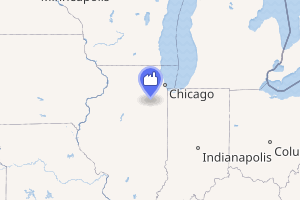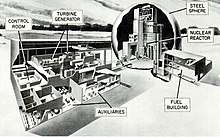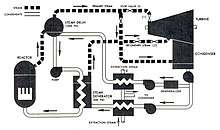Dresden Generating Station
Dresden Generating Station (also known as Dresden Nuclear Power Plant or Dresden Nuclear Power Station) is the first privately financed nuclear power plant built in the United States. Dresden 1 was activated in 1960 and retired in 1978. Operating since 1970 are Dresden units 2 and 3, two General Electric BWR-3 boiling water reactors. Dresden Station is located on a 953-acre (386 ha) site in Grundy County, Illinois, at the head of the Illinois River, near the city of Morris. It is immediately northeast of the Morris Operation—the only de facto high-level radioactive waste storage site in the United States. It serves Chicago and the northern quarter of the state of Illinois, capable of producing 867 megawatts of electricity from each of its two reactors, enough to power over one million average American homes.
| Dresden Generating Station | |
|---|---|
.jpg) Exterior view of Dresden Station circa 1971 | |

| |
| Country | United States |
| Location | Goose Lake Township, Grundy County, near Morris, Illinois |
| Coordinates | 41°23′23″N 88°16′5″W |
| Status | Operational |
| Construction began | Unit 1: May 1, 1956 Unit 2: January 10, 1966 Unit 3: October 14, 1966 |
| Commission date | Unit 1: July 4, 1960 Unit 2: June 9, 1970 Unit 3: November 16, 1971 |
| Decommission date | Unit 1: October 31, 1978 |
| Construction cost | Unit 1: $423 million (2010 USD) or $486 million in 2018 dollars[1] Unit 2: $856 million (2010 USD) or $983 million in 2018 dollars[1] Unit 3: $828 million (2010 USD) or $951 million in 2018 dollars[1] |
| Owner(s) | Exelon Corporation |
| Operator(s) | Exelon Generation Company, LLC |
| Nuclear power station | |
| Reactor type | BWR |
| Reactor supplier | General Electric |
| Cooling towers | 4 × Mechanical Draft (supplemental only) |
| Cooling source | Direct open-cycle mode:[lower-alpha 1] Closed-cycle mode:[lower-alpha 2] Indirect open-cycle mode:[lower-alpha 3] |
| Thermal capacity | 1 × 700 MWth (decommissioned) 2 × 2957 MWth |
| Power generation | |
| Units operational | 1 × 902 MW 1 × 895 MW |
| Make and model | Unit 1: BWR-1 (Mark 1) Units 2–3: BWR-3 (Mark 1) |
| Units decommissioned | 1 × 197 MW |
| Nameplate capacity | 1797 MW |
| Capacity factor | 98.13% (2017) 73.30% (lifetime, excluding Unit 1) |
| Annual net output | 15,447 GWh (2017) |
| External links | |
| Website | Dresden Generating Station |
| Commons | Related media on Commons |
.jpg)
In 2004, the Nuclear Regulatory Commission (NRC) renewed the operating licenses for both reactors, extending them from forty years to sixty.[2]
Unit 1

After the Atomic Energy Act of 1954 allowed private companies to own and operate nuclear facilities, Commonwealth Edison contracted with General Electric to design, construct, and place into operation the 192 MWe Dresden Unit 1 for $45M in 1955.[3] One-third of the contract price was shared by a consortium of eight companies comprising the Nuclear Power Group Inc.
The BWR at GE's Vallecitos Nuclear Center and the AEC's BORAX experiments provided research data and operator training for Dresden.
The core contained 488 fuel subassemblies, 80 control rods, and 8 instrument nozzles. Each subassembly contained 36 fuel rods in a Zircaloy-2 channel. The fuel was uranium dioxide clad in Zircaloy-2 tube. The core thermal power was 626 MWt. The reactor vessel was rated to 1015 psia and measured 12 ft. 2 in. diameter and 42 ft. tall.

The reactor featured a dual cycle, with steam coming from both the stream drum and steam generators. This made for rapid response to changes in power demand. Reactor power was regulated by actuation of the secondary admission valve by the turbine's governor. Decreasing the rate of secondary steam reduces reactor power, and vice versa. Thus, the secondary pressure varies with the external load.
Cooling
The plant has three cooling modes:
Direct open-cycle mode:[lower-alpha 4] Intake from canal leading to the Kankakee River,[lower-alpha 5] discharge directly to the Illinois River. The cooling canal system, cooling lake, and the supplementary cooling towers are completely bypassed in this mode of operation.
Indirect open-cycle mode:[lower-alpha 6] Intake from canal leading to the Kankakee River,[lower-alpha 5][lower-alpha 7] discharge to cooling canal leading to Dresden Cooling Lake,[lower-alpha 8] discharged from lake through return cooling canal that eventually discharges into the Illinois River. Use of the cooling towers for supplemental cooling of canal system water is usually necessary during this mode of operation.
Closed-cycle mode:[lower-alpha 9] Intake from return cooling canal leading back from Dresden Cooling Lake,[lower-alpha 10] discharge to cooling canal leading to Dresden Cooling Lake.[lower-alpha 8] Use of the cooling towers for supplemental cooling of canal system water is usually not necessary during this mode of operation.
It also has cooling towers[lower-alpha 11][lower-alpha 12]
Activity
Between the 1970s and 1996, Dresden was fined $1.6 million for 25 incidents.
- June 5, 1970: A minor instrumentation error on the Dresden II reactor caused the pressure to appear too high, triggering the turbine to dump steam (a "turbine trip"), which in turn automatically started a SCRAM. Void collapse in the re-condensing cooling water caused the water level to drop, which triggered an automatic increase in cooling flow. However, the pumps read low suction pressure at the inlet, which caused them to turn off to avoid running dry. One pump turned back on when this signal (which was later found to have been set incorrectly) turned off, feeding water which rapidly flowed into the now lower-pressure reactor vessel. At this point, the original spurious signal of high pressure disappeared. The dump valves closed, increasing the back pressure and slowing the inlet flow, while the cooling temperatures caused further void collapse. The core once again began to rapidly empty. This again automatically triggered the system to increase the flow rate, which worked properly and began to bring the reactor back to operating conditions. However, the indicator needle on the water depth gauge stuck in the low position, indicating a dangerous condition. The operator began increasing flow in order to raise the water level in the reactor, manually overriding the automatic system. A second gauge that showed the increasing levels was never checked. The water level rose until it was spilling out of the reactor, causing water to enter the main steam generator, a serious problem. Two minutes later, the needle unstuck, at which point the operator began reacting to the now high levels by spilling water and closing steam, causing a hydrostatic shock to form in the cooling pipes. This caused further reactions in the automated systems, and for the next 30 minutes the water levels and pressures seesawed as the operators attempted to get the reactor back to a stable level. It was not until two hours later that the reactor was finally shut down properly.[4] The movie The China Syndrome bases its initial plot device on this event, with the needle becoming unstuck when the operator taps the gauge.[5]
- December 8, 1971: Events similar to the ones the year earlier on Dresden II occur on Dresden III.[4]
- May 15, 1996: Lowering water levels around the nuclear fuel in unit 3[6] reactor's core prompt a shut down at Dresden Generating Station and placement on the NRC's "watch list" that merit closer scrutiny by regulators. Dresden was on the NRC watch list six out of nine years between 1987-1996, longer than any of the 70 other operating plants in the nation.[7]
- July 15, 2011: Plant declared an Alert at 10:16 a.m after a chemical leak of sodium hypochlorite restricted access to a vital area that houses plant cooling water pumps.[8]
Surrounding population
The Nuclear Regulatory Commission defines two emergency planning zones around nuclear power plants: a plume exposure pathway zone with a radius of 10 miles (16 km), concerned primarily with exposure to, and inhalation of, airborne radioactive contamination, and an ingestion pathway zone of about 50 miles (80 km), concerned primarily with ingestion of food and liquid contaminated by radioactivity.[9]
The 2010 U.S. population within 10 miles (16 km) of Dresden was 83,049, an increase of 47.6 percent in a decade, according to an analysis of U.S. Census data for msnbc.com. The 2010 U.S. population within 50 miles (80 km) was 7,305,482, an increase of 3.5 percent since 2000. Cities within 50 miles include Chicago (43 miles to city center).[10]
Ownership
Both currently operating units are owned and operated by Exelon, which also owns and is responsible for the decommissioning of Unit 1. Prior to August 3, 2000, all three units were owned by Commonwealth Edison.[11][12]
Seismic risk
The Nuclear Regulatory Commission's estimate of the risk each year of an earthquake intense enough to cause core damage to the reactor at Dresden was 1 in 52,632, according to an NRC study published in August 2010.[13][14]
Notes
- Currently only allowed when both units are out of service, rarely used.
- Used from October 1 through June 14.
- Used from June 15 through September 30, or approximately 8.5 months of the year.
- Currently only allowed when both units are out of service, rarely used.
- During periods of low river flow, intake water may also be indirectly drawn from the Des Plaines River.
- Used from June 15 through September 30, or approximately 8.5 months of the year.
- Up to 940,000 US gallons per minute (59 m3/s) is withdrawn from the river by six pumps each rated at 157,000 US gallons per minute (9.9 m3/s)).
- Water is pumped from the cooling canal into the 1,275 acres (516 ha) cooling lake via a lift station with 6 × 167,000 US gallons per minute (10.5 m3/s) pumps. The cooling lake has 5 zones through which the water slowly travels over the course of 2.5 days before it exits the cooling lake.
- Used from October 1 through June 14.
- Limited amounts (up to 70,000 US gallons per minute (4.4 m3/s)) of makeup water is drawn from the Kankakee River as needed,[lower-alpha 5] and limited discharge (up to 50,000 US gallons per minute (3.2 m3/s)) to the Illinois River happens in order to minimize dissolved solids concentrations in the cooling canals/lake.
- Prior to 2000, supplemental cooling was provided via spray canals (spray systems installed in both the hot and cold (return) cooling canals) rather than the current cooling towers.
- 1 × 12-cell tower (single-wide, built between 2000 and 2001), 2 × 18-cell towers (double-wide, built in 2000), and 1 × 6-cell tower (single-wide, built between 2003 and 2004) with an overall total of 54 cells. The 12-cell tower is only used for supplementary cooling of the cold (return) cooling canal as necessary in order to maintain discharge water temperatures within permitted levels, while the three other cooling towers are used for the supplementary cooling of water in the hot cooling canal. The three hot canal cooling towers are fed by 7 pumps rated at 135,067 US gallons per minute (8.5214 m3/s) each (total flow of 735,469 US gallons per minute (46.4009 m3/s)). The single 12-cell cold (return) canal cooling tower is fed by 24 pumps rated at 8,800 US gallons per minute (0.56 m3/s) each (total flow of 211,200 US gallons per minute (13.32 m3/s)). The 6-cell tower was added to provide additional cooling for the extended power uprates (+17%) on Units 2 & 3 that Exelon requested in December 2000, which were approved by the NRC in December 2001, although it was not until the end of 2002 that the uprates were implemented at both units (the units were also not operated at the uprated power for most of 2003 due to steam dryer cracking problems), and this additional cooling tower meant to provide additional cooling capacity to accommodate the additional thermal output from the outrate was not added until sometime between 2003 and 2004.
References
- Thomas, Ryland; Williamson, Samuel H. (2019). "What Was the U.S. GDP Then?". MeasuringWorth. Retrieved April 6, 2019. United States Gross Domestic Product deflator figures follow the Measuring Worth series.
- "Dresden and Quad Cities, Nuclear Power Stations — License Renewal Application". U.S. Nuclear Regulatory Commission (NRC). February 13, 2007. Retrieved 2008-11-19.
- "Power reactors". U.S. Atomic Energy Commission, Technical Information: 41–48. 1958-05-01. Retrieved 1 January 2020.
- 92nd CONGRESS. 22 March 22 to 10 April1972.
This action was forbidden...
Check date values in:|date=(help) - Ebert, Roger (1979-01-01). "The China Syndrome Movie Review (1979)". Roger Ebert. Retrieved 2013-12-30.
- NRC dispatches special inspection team to Dresden Nuclear Plant to review reactor shutdown on May 15 (RIII-96-17) U.S. Nuclear Regulatory Commission (NRC). May 16, 1996. Retrieved 10 June 2016.
- http://articles.chicagotribune.com/1996-06-26/news/9606260054_1_nuclear-power-plant-nuclear-regulatory-commission-station-manager
- "Archived copy". Archived from the original on 2013-06-16. Retrieved 2013-05-05.CS1 maint: archived copy as title (link)
- "NRC: Backgrounder on Emergency Preparedness at Nuclear Power Plants". Nrc.gov. Archived from the original on 2006-10-02. Retrieved 2012-08-17.
- Bill Dedman, Nuclear neighbors: Population rises near US reactors, NBC News, April 14, 2011 http://www.nbcnews.com/id/42555888 Accessed May 1, 2011.
- United States General Accounting Office (8 May 2004). NRC's Liability Insurance Requirements for Nuclear Power Plants Owned by Limited Liability Companies (PDF) (Report). United States General Accounting Office. p. 16. LCCN 2004398843. OCLC 56982748. GAO-04-654. Retrieved 29 April 2018.
- Nuclear Regulatory Commission (31 August 2000). "Commonwealth Edison Company; Dresden Nuclear Power Station, Units 1, 2 and 3; Notice of Consideration of Approval of Application Regarding Proposed Corporate Restructuring and Opportunity for a Hearing". Federal Register. Office of the Federal Register. Retrieved 29 April 2018.
- Bill Dedman, "What are the odds? US nuke plants ranked by quake risk," NBC News, March 17, 2011 http://www.nbcnews.com/id/42103936 Accessed April 19, 2011.
- "Archived copy" (PDF). Archived from the original (PDF) on 2017-05-25. Retrieved 2011-04-19.CS1 maint: archived copy as title (link)
External links
- "Dresden Nuclear Power Plant, Illinois". Energy Information Administration, U.S. Department of Energy (DOE). August 22, 2008. Archived from the original on July 10, 2009. Retrieved 2008-11-19.
- http://www.eia.gov/cneaf/nuclear/state_profiles/illinois/il.html#_ftn4
- https://www.nrc.gov/info-finder/decommissioning/power-reactor/dresden-nuclear-power-station-unit-1.html
- "Dresden 2 Boiling Water Reactor". Operating Nuclear Power Reactors. U.S. Nuclear Regulatory Commission (NRC). February 14, 2008. Retrieved 2008-11-19.
- "Dresden 3 Boiling Water Reactor". Operating Nuclear Power Reactors. NRC. February 14, 2008. Retrieved 2008-11-19.